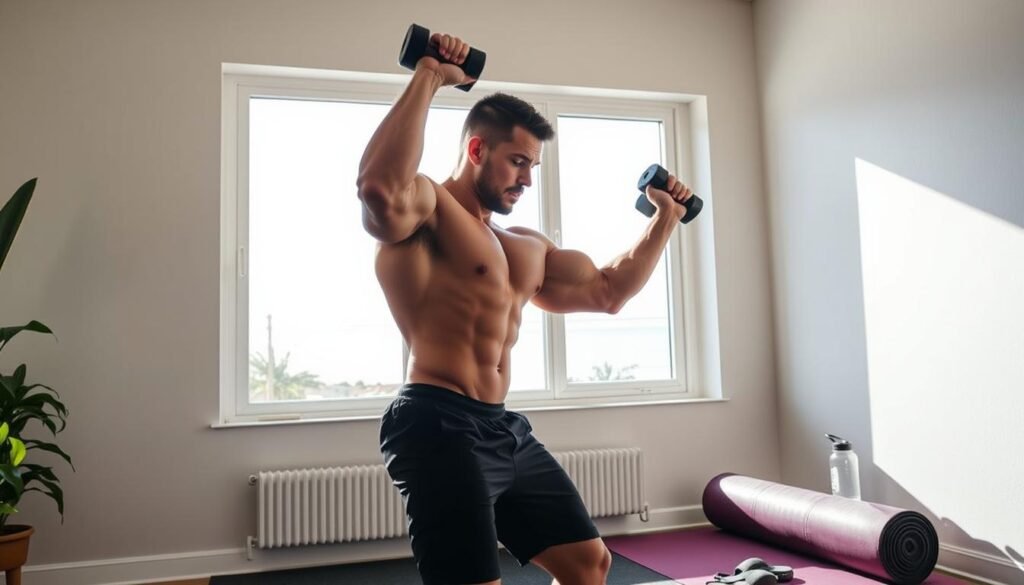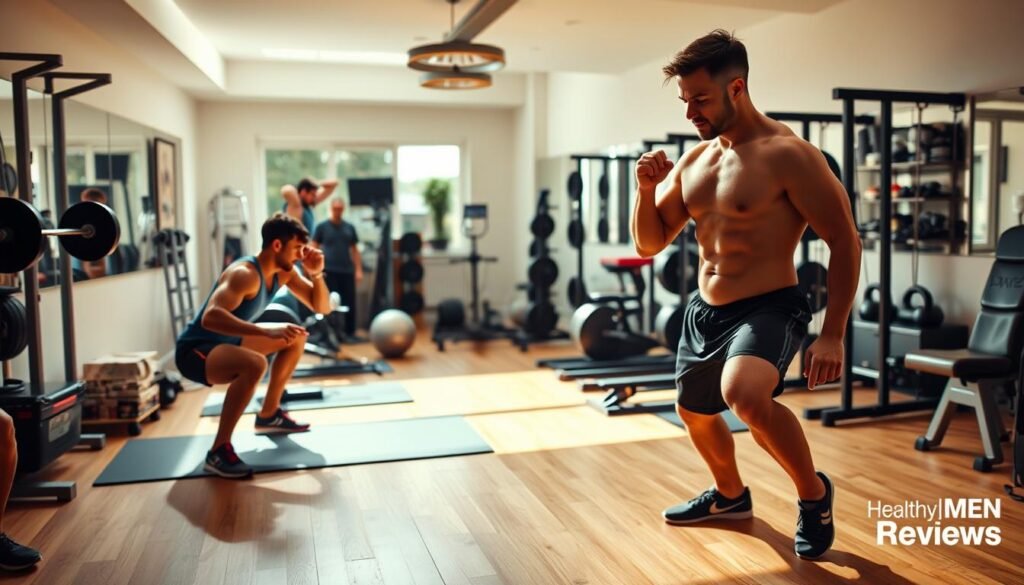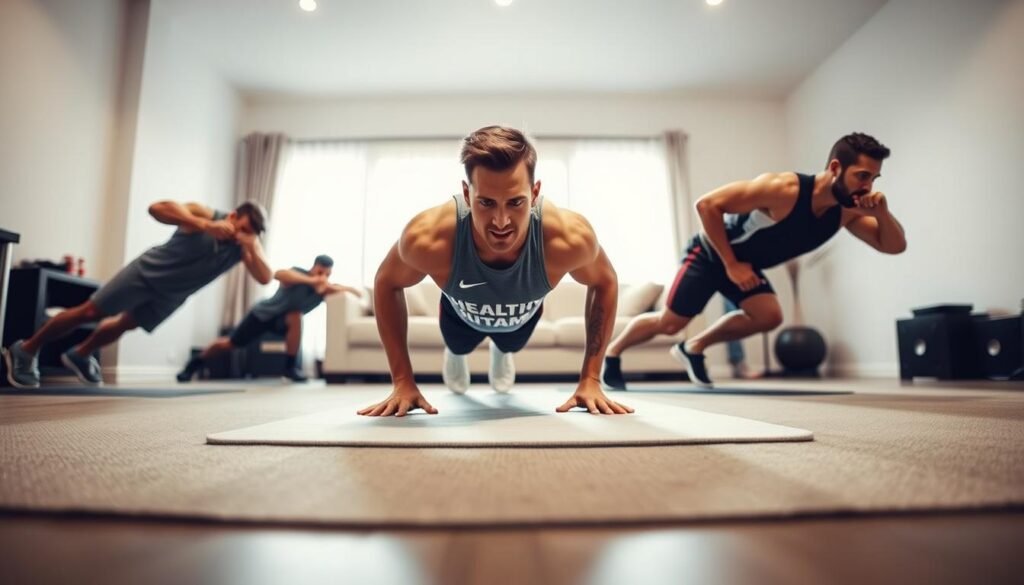Are you getting the most out of your home workout routine? Many men find it hard to reach their fitness goals because of common mistakes. Working out at home can make you lazy and forget about proper form and technique.
Without a good workout routine, you might not be working the right muscles or pushing hard enough. This can cause you to hit a plateau and get frustrated. Knowing the most common errors men make when working out at home can help you fix them. This way, you can have a more effective workout.
Key Takeaways
- Avoid common mistakes with a well-planned workout routine.
- Focus on proper form and technique to prevent injury.
- Don’t be too laid back – push yourself to achieve your fitness goals.
- Ensure you have the necessary equipment for an effective workout.
- Stay motivated and track your progress.
Why Men Are Turning to Home Workouts

More men are choosing home workouts for their convenience. Busy lives make it hard to go to the gym. Home workouts are a practical way to stay fit without leaving home.
The Convenience Factor: Time and Money Savings
Home workouts save men time and money. They don’t have to travel to the gym. This saves money on gym memberships and travel costs. Here’s how much you can save:
| Expense | Gym | Home Workout |
|---|---|---|
| Membership/Equipment | $50-$100/month | $0-$50 (one-time purchase) |
| Commute | $10-$20/month | $0 |
| Total | $60-$120/month | $0-$50 (initial investment) |
Pandemic-Driven Shift in Exercise Habits
The COVID-19 pandemic changed how we exercise. Gyms were closed, so men started working out at home. This change made them realize the benefits of home workouts. To get the most out of home workouts, tips for men’s home workouts include setting up a dedicated space and getting the right equipment.
The Psychological Benefits of Training at Home
Working out at home has mental benefits too. It helps men feel less intimidated and more comfortable. By avoiding exercise mistakes at home and focusing on form, they can reach their fitness goals better. Home workouts also offer privacy, which can reduce stress and help stay consistent.
To get the most from home workouts, it’s key to avoid common mistakes. Set achievable goals, track your progress, and mix up your routine. Include strength training, cardio, and flexibility exercises for a well-rounded workout.
Home Workout Mistakes Men Make: An Overview

Home workouts can be great, but men often make big mistakes. These mistakes can stop them from getting the results they want. It’s easy to fall into bad habits or miss important parts of a good workout routine.
Most Common Errors in At-Home Training
Some common mistakes include not having enough gear, being too relaxed, and not having a solid workout plan. These mistakes can stop you from getting better and might even hurt you.
- Insufficient equipment
- Lack of a structured workout plan
- Poor form and technique
How These Mistakes Limit Your Results
Without the right gear or a good plan, you won’t reach your fitness goals. Also, bad form can cause injuries. This can really slow you down.
The Importance of Proper Form and Technique
Good form and technique are key for safe and effective workouts. By doing exercises right, you get better results and avoid injuries.
Knowing these mistakes and fixing them can make your home workouts better. You’ll get the results you want.
Creating an Inadequate Workout Space
The environment where you work out at home is as crucial as the exercises you do. A well-designed space can boost your motivation and help you stay focused. This leads to better results in your workouts.
Why Your Environment Matters for Exercise Success
Your workout space greatly affects your success. A messy, noisy, or dimly lit area can be distracting. It makes it hard to stick to a workout routine. But, a dedicated, well-equipped space can keep you motivated and engaged.
How to Set Up an Effective Home Gym in Limited Space
Creating a home gym in a small space needs careful planning. First, pick a dedicated area for workouts, away from distractions and clutter. Use multi-functional gear like adjustable dumbbells or resistance bands to save space.
Essential vs. Optional Equipment for Men's Home Workouts
Distinguish between must-have and nice-to-have equipment for home workouts. Here’s a list of what’s essential and what’s optional for men’s home workouts:
| Equipment Type | Essential | Optional |
|---|---|---|
| Dumbbells | Yes | |
| Resistance Bands | Yes | |
| Pull-up Bar | Yes | |
| Kettlebells | Yes |
Knowing what’s essential and what’s optional helps you set up an effective home gym. This setup meets your needs and helps you reach your fitness goals.
Rushing Through or Skipping Warm-ups
Many men make the mistake of rushing through or skipping warm-ups during home workouts. Warming up is essential. It gets your body ready for the physical demands of exercise.
The Science Behind Proper Warm-up Protocols
A good warm-up boosts blood flow to your muscles and gets your heart rate up. It also readies your nervous system for exercise. This includes dynamic stretching and mobility exercises that match your workout’s movements. Studies prove that a proper warm-up enhances performance and lowers injury risk.
5-Minute Warm-up Routines That Actually Work
Here are quick warm-up routines that take just 5 minutes:
- Jumping jacks: 30 seconds
- Dynamic leg swings: 30 seconds per leg
- Arm circles: 30 seconds
- Torso twists: 30 seconds
- Light cardio (jogging in place, etc.): 1 minute
Mobility Exercises to Prevent Common Male Injuries
Mobility exercises are vital to avoid injuries like strains and pulls. They improve flexibility and range of motion. Try these:
- Hip circles to loosen the hip joint
- Knee lifts to prepare the legs
- Shoulder rolls to relax the upper body
Adding these warm-up routines to your home workouts helps correct workout errors for men and avoid exercise mistakes at home. A proper warm-up is crucial for a safe and effective workout.
Form and Technique Errors That Sabotage Results
Many men struggle with proper form and technique when exercising at home. This hinders their progress. Even with the best equipment and a well-planned routine, incorrect form can lead to injuries and negate the benefits of your workout.
Push-up and Pull-up Form Mistakes
Common mistakes during push-ups include letting the hips sag or arching the back. For pull-ups, using momentum or not fully extending the arms can reduce effectiveness. To correct these, focus on engaging your core and using controlled movements.
- Keep your body in a straight line from head to heels during push-ups.
- Avoid swinging or jerking during pull-ups.
Squat and Lunge Technique Errors
Squats and lunges are compound exercises that require precise technique. Common errors include not lowering enough or letting the knees extend past the toes. Proper form ensures you’re targeting the right muscles and minimizing the risk of injury.
- Lower your body until your thighs are parallel to the ground during squats.
- Keep your front knee behind your toes during lunges.
How to Self-Check Your Form Without a Trainer
Self-checking your form is crucial for making adjustments and avoiding bad habits. Two effective methods include using mirrors and video recording.
Using Mirrors and Video Recording
Using a mirror allows you to observe your form in real-time. Video recording can help you analyze your technique more thoroughly. Pay attention to your posture, movement, and alignment.
Developing body awareness can significantly improve your technique. Focus on cues like engaging your core, squeezing your glutes, or keeping your back straight. These cues help you maintain proper form and get the most out of your exercises.
By addressing these common form and technique errors, you can improve your at-home workouts and achieve better results. Regularly checking your form and making necessary adjustments will help you stay on track and avoid plateaus.
Equipment Selection and Usage Mistakes
Men often make mistakes when choosing and using home workout equipment. The right gear can boost your workout, but the wrong choice can lead to frustration. It can also stop you from improving.
Investing in Unnecessary or Ineffective Gear
Many men spend too much on equipment that doesn’t fit their fitness goals. They also might not have enough space for it at home. Before buying, think about what you need and what you want to achieve.
Think about the exercises you want to do and how much space you have. This will help you choose the right equipment for your home gym.
Not Maximizing the Equipment You Already Have
It’s common to want new equipment, but often, men don’t use what they already have. Take time to learn new exercises you can do with your current gear.
For example, dumbbells can be used for many exercises like bicep curls and squats. Trying different exercises keeps your workouts fresh and interesting.
Creative Alternatives to Expensive Equipment
You don’t have to spend a lot to have a good home gym. There are many creative, affordable alternatives to expensive equipment.
Household Items That Double as Fitness Tools
Items like water bottles and chairs can be used as gym equipment. For example, a chair can be used for tricep dips or step-ups.
- Use water bottles as dumbbells for arm curls.
- Employ a chair for support during single-leg squats.
- Utilize a towel for resistance exercises.
Bodyweight Exercise Progressions
Bodyweight exercises are great for working out without any equipment. By changing the intensity and difficulty, you can keep challenging yourself and improving.
Try progressing from push-ups to diamond push-ups, or from squats to single-leg squats. These changes can be as effective as using expensive equipment.
Programming and Progression Errors
Men working out at home often make common mistakes. These errors can hinder their progress. It’s important to know these mistakes to improve your workouts.
Failing to Implement Progressive Overload
Progressive overload is key for muscle growth and strength. It means slowly increasing the weight or intensity of your workouts. Without it, your muscles won’t grow or get stronger.
To increase the challenge, you can lift heavier weights, do more reps, or rest less between sets. For example, if you’re doing squats with 100 lbs, try lifting 105 lbs, doing 12 reps, or adding another set.
Creating Imbalanced Training Splits
An imbalanced training split happens when you focus too much on some muscles. This can lead to muscle imbalances and increase injury risk.
To avoid this, make sure your workouts cover all major muscle groups. For example, in a push-pull-legs split, balance your exercises. Don’t overdo the pushing exercises and neglect the pulling ones.
Not Tracking Workouts and Progress
Tracking your workouts is crucial. It helps you see what’s working and what’s not. Without it, you can’t make smart changes to your routine.
Use a workout log or fitness app to track your exercises and progress. Regularly reviewing your progress helps you stay motivated and identify areas for improvement.
Effective Programming Strategies for Home Training
Good programming is essential for a successful home workout. It involves planning, setting goals, and changing your routine to avoid plateaus.
| Strategy | Description | Benefit |
|---|---|---|
| Periodization | Alternating between different training phases (e.g., strength, hypertrophy) | Avoids plateaus and prevents overtraining |
| Variety in Exercises | Including a mix of compound exercises and isolation exercises | Ensures overall muscle development and prevents boredom |
| Progressive Overload | Gradually increasing weight or resistance | Promotes continuous muscle growth and strength gains |
By understanding and correcting these errors, you can greatly improve your home workouts. This will help you reach your fitness goals more effectively.
Recovery Mistakes That Hinder Muscle Growth
To grow muscle at home, knowing recovery mistakes is key. Working out causes micro-tears that need to heal. Neglecting recovery can stop your progress.
Overtraining Without Adequate Rest
Many men overtrain at home. Without rest, muscles can’t heal, leading to poor performance and injury. Make sure to rest your muscles by taking rest days.
- Rest each muscle group for at least 48 hours before working it again.
- Listen to your body; if you’re tired, it’s time for a rest day.
Sleep Quality and Its Impact on Fitness Results
Sleep is vital for muscle repair and growth. Poor sleep can hurt your fitness, so focus on good sleep habits.
“Sleep is the golden chain that ties health and our bodies together.” – Thomas Dekker
For better sleep, keep a regular sleep schedule and have a calming bedtime routine.
Active Recovery Techniques for Home Exercisers
Active recovery boosts blood flow and helps heal. At home, you can use foam rolling, stretching, and light cardio to recover better.
Stress Management for Optimal Recovery
Too much stress can harm recovery by raising cortisol, which breaks down muscle. Try stress-reducing activities like meditation, yoga, or deep breathing to lower stress.
- Use mindfulness to reduce stress.
- Make time for relaxation and fun activities.
Avoiding these recovery mistakes can help you grow muscle better and get more from your home workouts.
Nutrition Blunders Connected to Home Workouts
Nutrition is key to success in home workouts, but many men make big mistakes. Working out at home can lead to unhealthy eating habits. It’s important to pay attention to nutrition.
Kitchen Proximity and Mindless Eating
Working out at home means you’re close to the kitchen. This can cause mindless eating. It’s easy to snack too much, feeling bored or stressed. Create a clear line between your workout area and kitchen.
Pre and Post-Workout Nutrition Timing
Getting your nutrition right is important. Eat a balanced meal or snack before working out to have energy. After, eat protein and carbs to help muscles recover and grow.
Hydration Strategies for Home Training
Drinking water is crucial for performance and recovery. Make sure to drink water before, during, and after your workout. Aim for 8-10 glasses of water a day, more for intense workouts.
Protein Intake Miscalculations
Protein is essential for muscle repair and growth. But many men don’t get enough. Aim for 1.2-1.6 grams of protein per kilogram of body weight daily. Spread it across meals and snacks.
Knowing these common nutrition mistakes can help you improve your home workout results. This way, you can reach your fitness goals more effectively.
Conclusion: Transforming Your Home Workout Approach
Now that you know the common mistakes in home workouts for men, it’s time to change your approach. Fixing these errors is key to better home workouts and reaching your fitness goals. Focus on the right form and technique to get the best results and avoid injuries.
Having a good workout plan is also important. This means creating a balanced routine, increasing weights over time, and tracking your progress. Remember, recovery and nutrition are just as important for muscle growth and fitness.
By avoiding common mistakes and using these strategies, you can improve your home workouts. Start by reviewing your current routine and making changes. With dedication and a focus on correcting mistakes, you can see better results and enjoy a more effective workout at home.

